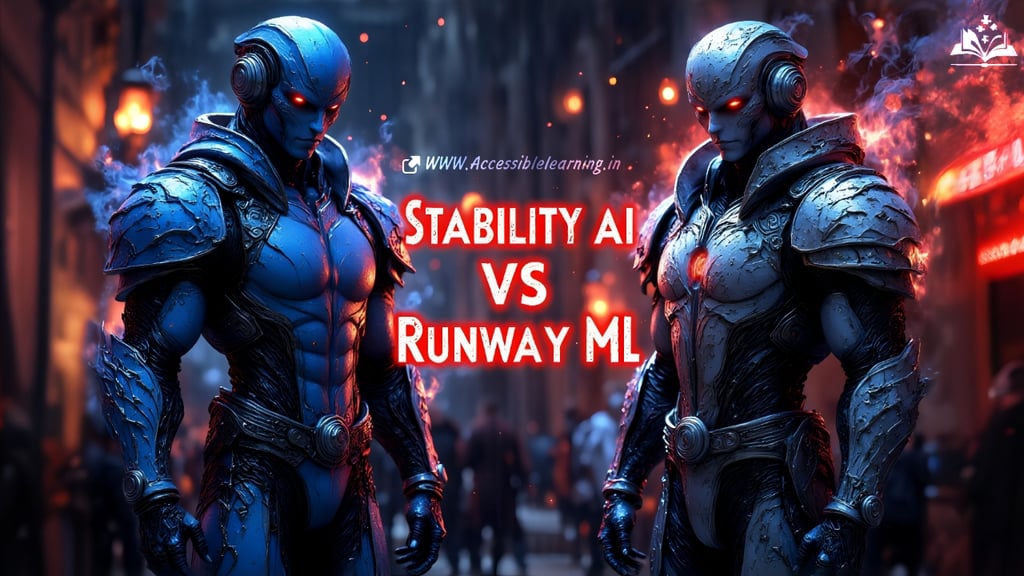
Creative AI Tools in Focus: Runway ML vs Stability AI
Explore the in-depth comparison of Runway ML vs Stability AI, two leading platforms revolutionizing creative and industrial applications of AI. Understand their features, technical insights, and use cases to choose the ideal solution for your needs.
AI ART TOOLSAI/FUTUREEDITOR/TOOLSARTIST/CREATIVITY
Sachin K Chaurasiya
1/30/20255 min read


The field of artificial intelligence has undergone significant advancements, with creative AI platforms like Runway ML and Stability AI taking center stage. These platforms empower artists, designers, researchers, and developers to create innovative works by harnessing the potential of AI. This article delves into the capabilities, features, strengths, and unique offerings of Runway ML and Stability AI, providing a thorough comparison to help you determine which platform suits your needs best.
Runway ML
Runway ML is an AI-powered creative toolkit that simplifies machine learning for artists, designers, and developers. It offers a user-friendly interface, allowing users to explore and implement various machine learning models without requiring extensive programming expertise. Runway ML focuses on enabling creativity, offering tools for image generation, video editing, and more.
Technical Features of Runway ML
Backend Architecture: Runway ML operates using a cloud-based infrastructure, which ensures efficient model processing and scalability.
Model Support: It supports popular frameworks such as TensorFlow, PyTorch, and ONNX, providing compatibility with a wide range of pre-trained models.
API Access: Runway ML provides APIs for integration with other applications, enabling developers to embed AI functionalities into custom workflows.
Edge Deployment: The platform supports exporting models for edge devices, making it possible to deploy lightweight solutions locally.
GPU Acceleration: With GPU support, Runway ML ensures faster model inference and training.
Supported Models: Includes Stable Diffusion for text-to-image generation, GPT-based models for text tasks, and more specialized models for video and audio processing.
Key Features
Text-to-Image Generation: With tools like Stable Diffusion, Runway ML allows users to generate images from text prompts, making it a favorite among digital artists.
Video Editing: The platform includes AI-powered video editing features such as rotoscoping and background removal, saving hours of manual work.
Model Hub: Runway ML provides access to a vast library of pre-trained machine learning models, catering to diverse creative needs.
No-Code Environment: The platform’s drag-and-drop interface eliminates the need for complex coding, making it accessible to non-technical users.
Collaboration Tools: Runway ML supports teamwork with features that facilitate project sharing and collaborative editing.
Integrations: Runway ML integrates seamlessly with creative software like Adobe Premiere Pro and After Effects, enhancing workflows for professionals.
AI-Powered Animations: Users can create animations using generative AI tools, breathing life into static images.
Applications
Graphic design and illustration
Video production and editing
Social media content creation
Research and prototyping for creative projects
Educational projects and interactive demonstrations


Stability AI
Stability AI is a leading open-source AI platform, primarily known for its work on the Stable Diffusion model, a groundbreaking text-to-image generator. The organization emphasizes transparency, collaboration, and community-driven development, making its tools highly customizable and adaptable for various applications.
Technical Features of Stability AI
Core Frameworks: Stability AI relies on PyTorch as its primary deep learning framework, ensuring robust performance and wide compatibility.
Stable Diffusion: Built using latent diffusion models (LDMs), Stable Diffusion leverages latent space representations to achieve high-quality image generation with reduced computational resources.
Open-Source Codebase: The platform's source code is publicly available on repositories like GitHub, allowing developers to modify and contribute to its ecosystem.
Multi-GPU Support: Stability AI can scale across multiple GPUs, enabling faster training and inference for large-scale applications.
Custom Training: Users can fine-tune pre-trained models using proprietary datasets, tailoring outputs to specific requirements.
Optimization Techniques: Stability AI employs memory-efficient optimizations, including mixed-precision training and reduced model size for faster processing.
Deployment Options: Supports cloud-based, on-premises, and edge deployments for flexible integration into diverse environments.
Key Features
Stable Diffusion: This flagship model excels in generating high-quality images from textual descriptions, offering unparalleled customization.
Open-Source Framework: Stability AI’s commitment to open-source development allows users to modify and build upon existing models, fostering innovation.
Scalability: Stability AI is designed to handle large-scale deployments, making it ideal for enterprise-level applications.
Community-Driven: The platform thrives on a vibrant community of developers and researchers who actively contribute to its ecosystem.
High Performance: Stability AI’s models are optimized for efficiency, enabling faster processing times and reduced resource consumption.
Advanced Tools: Stability AI supports fine-tuning and training custom models, giving users control over output quality and functionality.
Cross-Domain Applications: Beyond creative tasks, Stability AI’s models are used in fields like medical imaging, scientific research, and industrial design.
Applications
Text-to-image and image enhancement projects
Research and experimentation in AI
Commercial and industrial design
Development of new AI-powered tools
Real-time applications like augmented reality (AR) and virtual reality (VR)


Runway ML vs Stability AI: Head-to-Head Comparison
Ease of Use
Runway ML: Designed for non-technical users, Runway ML offers a seamless, no-code environment. Its intuitive interface makes it ideal for artists and designers who want to dive into AI without technical barriers.
Stability AI: While Stability AI is powerful, its open-source nature requires some technical expertise. Users need a basic understanding of programming and model deployment to leverage its full potential.
Customization
Runway ML: Customization is somewhat limited compared to Stability AI, as the platform is tailored for ease of use rather than deep technical modification.
Stability AI: Offers extensive customization options, allowing developers to tweak models and create tailored solutions for specific needs.
Community & Collaboration
Runway ML: Provides built-in collaboration tools, making it a go-to choice for teams working on creative projects.
Stability AI: Relies heavily on its open-source community, which contributes to a constantly evolving ecosystem of models and tools.
Performance & Scalability
Runway ML: Suited for small- to medium-scale projects, Runway ML is a great choice for individual creators and small teams.
Stability AI: Designed for scalability, Stability AI can handle large-scale enterprise applications, making it ideal for businesses and researchers with significant computational needs.
Pricing
Runway ML: Operates on a subscription-based model, offering tiered plans to cater to various user needs.
Stability AI: As an open-source platform, Stability AI is free to use, though users may incur costs for cloud computing resources and custom model training.
Innovation & Experimentation
Runway ML: Focuses on pre-packaged tools and features, streamlining workflows for creatives who value simplicity.
Stability AI: Encourages experimentation by providing access to underlying model architectures, fostering innovation among developers and researchers.
Choosing the Right Platform for Your Needs?
The choice between Runway ML and Stability AI largely depends on your objectives, technical expertise, and project requirements.
Runway ML is the ideal choice for creatives seeking an easy-to-use platform with pre-built tools for image and video projects. Its no-code environment makes it particularly appealing to those without a technical background.
Stability AI, on the other hand, is best suited for developers and researchers who value open-source flexibility and need a platform that can scale for enterprise or experimental projects.


Runway ML and Stability AI both offer exceptional tools for leveraging AI in creative and industrial applications. Runway ML excels in accessibility and user-friendliness, while Stability AI stands out for its open-source ethos and scalability. By understanding their unique strengths, you can select the platform that aligns with your vision and technical capabilities, unlocking new possibilities in the ever-evolving world of AI.
Whether you are a creative professional, a researcher, or a business looking to integrate AI solutions, both platforms provide robust options tailored to specific needs. Embrace the power of AI and explore the endless opportunities it brings to your projects.
Subscribe To Our Newsletter
All © Copyright reserved by Accessible-Learning Hub
| Terms & Conditions
Knowledge is power. Learn with Us. 📚


